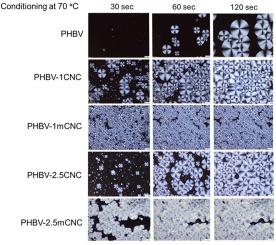Our official English website, www.x-mol.net, welcomes your
feedback! (Note: you will need to create a separate account there.)
Crystallization and performance evolution of PHBV nanocomposites through annealing: The role of surface modification of CNCs
Polymer ( IF 4.1 ) Pub Date : 2024-07-01 , DOI: 10.1016/j.polymer.2024.127352 Elnaz Esmizadeh , Arvind Gupta , Samuel Asrat , Tizazu H. Mekonnen
Polymer ( IF 4.1 ) Pub Date : 2024-07-01 , DOI: 10.1016/j.polymer.2024.127352 Elnaz Esmizadeh , Arvind Gupta , Samuel Asrat , Tizazu H. Mekonnen

|
To address the brittleness challenge of polyhydroxybutyrate-co-valerate (PHBV) rooting from its slow nucleation rate, cellulose nanocrystals (CNCs) were employed as bio-based nano nucleation and reinforcement agents. CNCs were further functionalized through succinylation using aliphatic dodecyl succinic anhydride (DDSA), for improved compatibility and dispersion within PHBV. Nanocomposites of PHBV incorporating pristine or DDSA-modified CNC (mCNC) were prepared through solution mixing followed by melt injection molding. The study focused on investigating how CNCs and mCNCs affect the crystallization behavior, thermal, rheological, and mechanical properties of PHBV nanocomposites over time, in the course of annealing or conditioning. Thermal results revealed that the incorporation of neat CNCs generally improving stability due to restricted polymer chain mobility and hydrogen bonding, while DDSA-modified CNCs show varied effects depending on the concentration, sometimes diminishing stability due to increased chain mobility. Polarized optical microscopy revealed the superior nucleation efficiency of mCNC, especially at low contents, leading to smaller and numerous spherulites over conditioning. Rheological analysis indicated a dilution effect of the hairy mCNCs, decreasing both dynamic modulus and complex viscosity. Mechanical properties, assessed through tensile testing and dynamic mechanical analysis after 15 days of conditioning, demonstrated the evolving effect of CNCs on aging-induced embrittlement and thermo-mechanical performance of PHBV during storage. The results revealed that incorporating 1 wt% mCNCs effectively toughened PHBV, increasing Young's modulus, and decreasing Tg without scarifying elongation at break compared to neat PHBV. The findings position mCNCs as a promising nucleation agent which retains PHBV nanocomposites toughness after aging.
中文翻译:

PHBV 纳米复合材料通过退火的结晶和性能演变:CNC 表面改性的作用
为了解决聚羟基丁酸酯-戊酸酯 (PHBV) 因成核速率缓慢而带来的脆性挑战,采用纤维素纳米晶体 (CNC) 作为生物基纳米成核剂和增强剂。通过使用脂肪族十二烷基琥珀酸酐 (DDSA) 进行琥珀酰化,CNC 进一步功能化,以改善 PHBV 中的相容性和分散性。通过溶液混合和熔融注射成型制备了含有原始或 DDSA 改性 CNC (mCNC) 的 PHBV 纳米复合材料。该研究的重点是研究 CNC 和 mCNC 在退火或调节过程中如何随时间影响 PHBV 纳米复合材料的结晶行为、热学、流变学和机械性能。热结果表明,由于限制了聚合物链的流动性和氢键,纯 CNC 的加入通常会提高稳定性,而 DDSA 改性的 CNC 则根据浓度的不同显示出不同的效果,有时会由于链流动性的增加而降低稳定性。偏光光学显微镜揭示了 mCNC 卓越的成核效率,尤其是在低含量的情况下,导致过度调节时产生更小且数量更多的球晶。流变学分析表明毛状 mCNC 具有稀释效应,降低了动态模量和复数粘度。经过 15 天的调节后,通过拉伸测试和动态机械分析评估机械性能,证明了 CNC 对 PHBV 在储存过程中老化引起的脆化和热机械性能的影响。结果表明,与纯 PHBV 相比,掺入 1 wt% mCNC 可有效增韧 PHBV,提高杨氏模量并降低 Tg,且不会降低断裂伸长率。 这些发现将 mCNC 定位为一种有前途的成核剂,它在老化后仍能保持 PHBV 纳米复合材料的韧性。
更新日期:2024-07-01
中文翻译:

PHBV 纳米复合材料通过退火的结晶和性能演变:CNC 表面改性的作用
为了解决聚羟基丁酸酯-戊酸酯 (PHBV) 因成核速率缓慢而带来的脆性挑战,采用纤维素纳米晶体 (CNC) 作为生物基纳米成核剂和增强剂。通过使用脂肪族十二烷基琥珀酸酐 (DDSA) 进行琥珀酰化,CNC 进一步功能化,以改善 PHBV 中的相容性和分散性。通过溶液混合和熔融注射成型制备了含有原始或 DDSA 改性 CNC (mCNC) 的 PHBV 纳米复合材料。该研究的重点是研究 CNC 和 mCNC 在退火或调节过程中如何随时间影响 PHBV 纳米复合材料的结晶行为、热学、流变学和机械性能。热结果表明,由于限制了聚合物链的流动性和氢键,纯 CNC 的加入通常会提高稳定性,而 DDSA 改性的 CNC 则根据浓度的不同显示出不同的效果,有时会由于链流动性的增加而降低稳定性。偏光光学显微镜揭示了 mCNC 卓越的成核效率,尤其是在低含量的情况下,导致过度调节时产生更小且数量更多的球晶。流变学分析表明毛状 mCNC 具有稀释效应,降低了动态模量和复数粘度。经过 15 天的调节后,通过拉伸测试和动态机械分析评估机械性能,证明了 CNC 对 PHBV 在储存过程中老化引起的脆化和热机械性能的影响。结果表明,与纯 PHBV 相比,掺入 1 wt% mCNC 可有效增韧 PHBV,提高杨氏模量并降低 Tg,且不会降低断裂伸长率。 这些发现将 mCNC 定位为一种有前途的成核剂,它在老化后仍能保持 PHBV 纳米复合材料的韧性。

















































 京公网安备 11010802027423号
京公网安备 11010802027423号